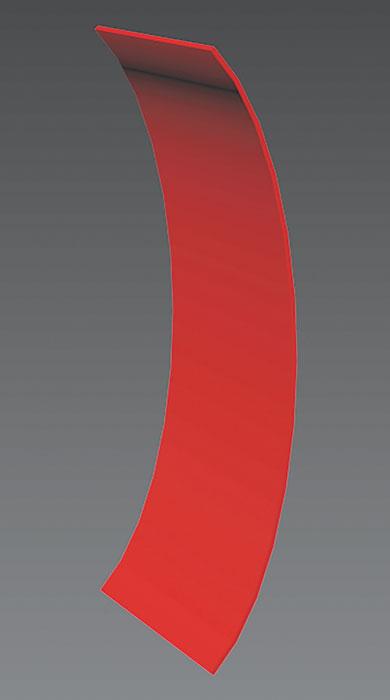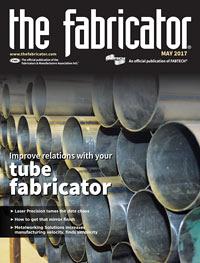- FMA
- The Fabricator
- FABTECH
- Canadian Metalworking
Categories
- Additive Manufacturing
- Aluminum Welding
- Arc Welding
- Assembly and Joining
- Automation and Robotics
- Bending and Forming
- Consumables
- Cutting and Weld Prep
- Electric Vehicles
- En Español
- Finishing
- Hydroforming
- Laser Cutting
- Laser Welding
- Machining
- Manufacturing Software
- Materials Handling
- Metals/Materials
- Oxyfuel Cutting
- Plasma Cutting
- Power Tools
- Punching and Other Holemaking
- Roll Forming
- Safety
- Sawing
- Shearing
- Shop Management
- Testing and Measuring
- Tube and Pipe Fabrication
- Tube and Pipe Production
- Waterjet Cutting
Industry Directory
Webcasts
Podcasts
FAB 40
Advertise
Subscribe
Account Login
Search
Plate rolling challenge: Taking a crack at rolling aluminum
Sometimes, outsourcing is the best option
- By Steve Benson
- May 3, 2017
- Article
- Bending and Forming

Rolling material susceptible to cracking can require heat treating, and forming it just right on a slip roll can require experience and expertise.
Question: Do you know of any techniques for bending a wide curve in relatively thick nonferrous material, such as 1/8-inch-thick aluminum plate (see figure)? If I’m not mistaken, aluminum cracks when it gets hot, so I know that using a torch or hand bending it is a no-go.
My first thought was to use a slip roll, but they all seem to top out at 16 gauge (for ferrous material). Without spending $20,000 on a slip-roll machine that can bend something thicker than 16 ga., how can I get big, wide, repeatable, and uniformly even curves in aluminum?
I’m considering just buying an inexpensive slip roll (sold online for hobby and home use) and seeing for myself if my 1/8-in. aluminum will bend. Failing that, my next idea is to buy the largest-diameter steel pipe that I can afford and attempt to cobble together a homemade slip roll. Any ideas?
Answer: Short of slip rolling, the only way to build this part in a press brake is by bump-radius forming; this will work, but it is time-consuming and makes it difficult to maintain consistency.
Regarding aluminum’s tendency to crack, some grades crack relatively easily, but rarely will aluminum crack when bent or rolled into an arc. The cracking (or more likely the complete breaking of the sheet) occurs when the bend angle exceeds 80 degrees complementary.
Aluminum grades T4 and T6 tend to exhibit this property. Nonetheless, even these can be heated in an oven or with a torch. This annealing (softening) allows the aluminum to be formed easily, much the way you would work a mild carbon steel. Cracking or complete breaking is much more likely to occur if you bend with the material grain rather than across it.
Corrosion Factors
Corrosion can make it even more likely for the aluminum to crack under sustained stress. Manifesting itself as “white rust,” aluminum corrosion causes etching or pitting and gives the material surface a general roughness.
As the sheet or plate is created and the aluminum alloy cools, a very thin, smooth, transparent, passive oxide film—anywhere between 0.001 and 0.0025 in. thick—encases the material. This passive oxide surface film occurs naturally and is not considered detrimental to the material. In fact, the film creates a barrier that protects against corrosive elements. (Note that this is different from the excessive white rust corrosion described earlier.)
Corrosive elements penetrate slowly but progress faster in the presence of dissolved salts or even rain. Nonetheless, it takes a considerable amount of corrosion before the material loses a serious amount of integrity.
Why do I bring this up? Because, if you are annealing the material in-house—that is, making the metal softer by heating it with an acetylene torch before bending—you need to know how the passive oxide film creates a hard outer shell as the material cools.
If you heat the aluminum too much (usually with an acetylene torch rather than an oven), you can get “blowouts” or “burn-throughs.” The passive oxide film melts at a higher temperature than the base aluminum. Everything looks fine and then, for what seems like no reason whatsoever, you’ve blown a hole in your part, and you never saw it coming.
If you plan to heat your material, use caution and get a tool that measures heat. Aluminum does not change color when heated, so burns are a real concern. To mitigate heating-related issues, you can purchase an inexpensive infrared laser thermometer.
Regarding your idea of buying a roll from a discount supplier for hobbyist and home use, from my experience this really isn’t a viable option. Discount tools are great for the home shop, but they are not so good for production. Let’s be honest, the quality just isn’t there. You will spend a fortune in labor just trying to true the roll in, and you still may not be able to get two consistent pieces in a row.
All the same, problems associated with purchasing a discount roll will pale in comparison to those you will face with a homemade slip roll. While rollers, like press brakes, seem to be viewed as very simple machines, they are anything but. Rolls and press brakes are in fact the two most difficult machines to operate successfully in the fab shop.
You might consider purchasing a used power roller. I suggest you review the various types of slip rolls—2-roll, 3-roll pyramid, and 4-roll variable, just to name a few. Still, even used rolls do not come cheap.
In a Softer State
I do not know the details about the type or series of aluminum that you are using, but considering you are concerned with cracking and breaking, I assume the material is somewhat brittle. If this were my project, rather than build my parts from material in the finished condition as called for on the print, I’d create these parts from material in the “O” condition, where the aluminum is very soft and easily bent or rolled.
Once you’ve finished forming the pieces, you can send them out to be tempered to the desired hardness state. If you do this, be sure to run a couple pieces and get them heat-treated and reviewed by quality control.
Tempering heats the material, which can change the geometry of your piece, which means you most likely will have dimensional variations. Once your test pieces have returned from heat treating and QC has checked them, note the changes in dimension between the parts in their treated and untreated states.
For example, the radius might relax because of the heating. This, of course, would then change the dimensions. Now, armed with that information, head back to the roller or press brake, make some adjustments to compensate for the variations heat treating caused, and run the parts.
The Subcontracting Option
If you plan on adding a slip roller, press brake, or any new piece of equipment to your shop’s repertoire, consider your return on investment. Is the job large or long enough to justify the purchase of that new or used piece of equipment? If it is, expand and grow your expertise.
If not, consider subcontracting the job out to someone who already has the equipment, the expertise, and the practical working knowledge to complete the project. That way, you can make a few dollars on a pass-through project rather than spending time and money buying equipment and expanding your skill set.
This is especially true for rolling. It takes time for an operator to learn how to produce consistent, quality workpieces on a slip roll, even under the best of circumstances. Short of using a CNC-based 4-roll machine, you will find it difficult to shorten the learning curve, especially if you don’t want to spend much money on equipment. Each step down in equipment type and quality will produce a corresponding increase in the learning curve and labor costs.
Sometimes, it is financially prudent to let others handle it and just settle instead for a small markup.
Steve Benson is a member and former chair of the Precision Sheet Metal Technology Council of the Fabricators & Manufacturers Association International®. He is the president of ASMA LLC, steve@theartofpressbrake.com. Benson also conducts FMA’s Precision Press Brake Certificate Program, which is held at locations across the country. For more information, visit www.fmanet.org/training, or call 888-394-4362. For more information on bending, check out Benson’s book, theArtofPressBrake: the Digital Handbook for Precision Sheet Metal Fabrication, ©2014, available at www.theartof pressbrake.com. The author’s latest book on press brake bending, published by FMA, will be available soon.
About the Author

Steve Benson
2952 Doaks Ferry Road N.W.
Salem, OR 97301-4468
503-399-7514
Related Companies
subscribe now

The Fabricator is North America's leading magazine for the metal forming and fabricating industry. The magazine delivers the news, technical articles, and case histories that enable fabricators to do their jobs more efficiently. The Fabricator has served the industry since 1970.
start your free subscription- Stay connected from anywhere

Easily access valuable industry resources now with full access to the digital edition of The Fabricator.

Easily access valuable industry resources now with full access to the digital edition of The Welder.

Easily access valuable industry resources now with full access to the digital edition of The Tube and Pipe Journal.
- Podcasting
- Podcast:
- The Fabricator Podcast
- Published:
- 04/16/2024
- Running Time:
- 63:29
In this episode of The Fabricator Podcast, Caleb Chamberlain, co-founder and CEO of OSH Cut, discusses his company’s...
- Trending Articles
AI, machine learning, and the future of metal fabrication

Employee ownership: The best way to ensure engagement

Steel industry reacts to Nucor’s new weekly published HRC price

Dynamic Metal blossoms with each passing year

Metal fabrication management: A guide for new supervisors

- Industry Events
16th Annual Safety Conference
- April 30 - May 1, 2024
- Elgin,
Pipe and Tube Conference
- May 21 - 22, 2024
- Omaha, NE
World-Class Roll Forming Workshop
- June 5 - 6, 2024
- Louisville, KY
Advanced Laser Application Workshop
- June 25 - 27, 2024
- Novi, MI


























